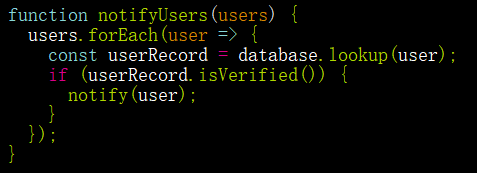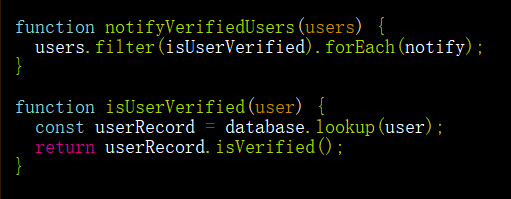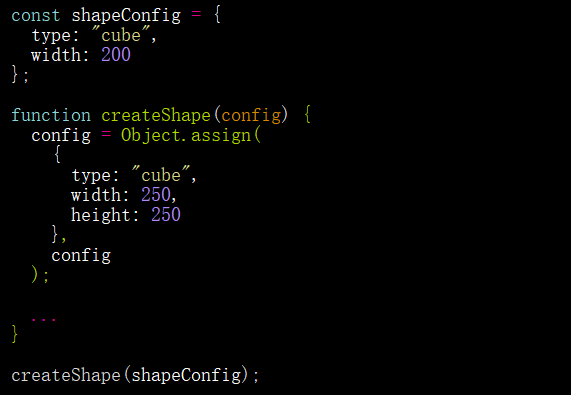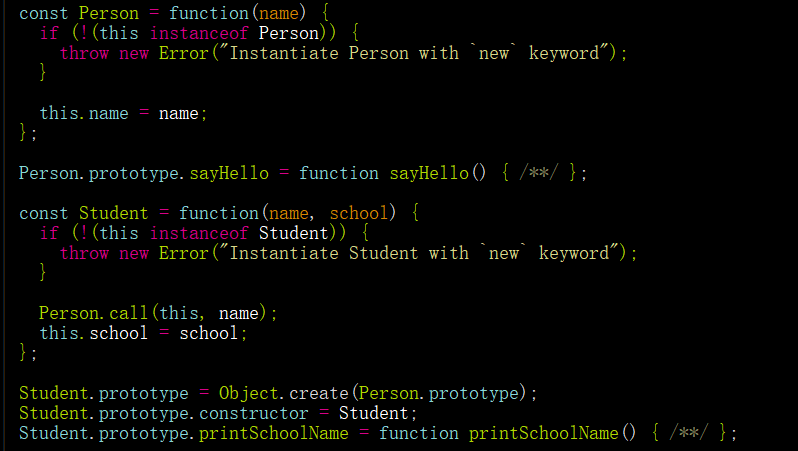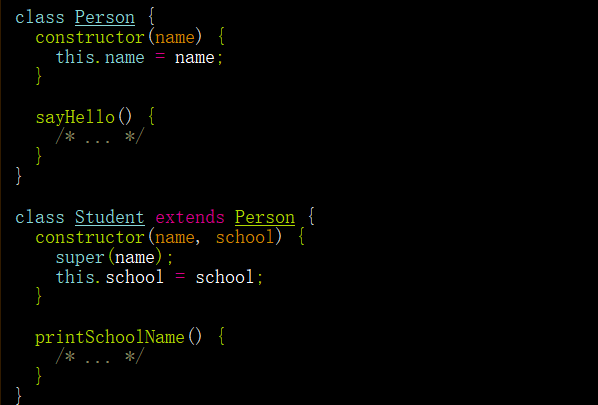
概述
我们之道作为一个码农,不论其实现如何,功能怎样,写的一手清晰靠谱的代码是其代码功力的体现。好的、清洁的代码可以方便自己以后维护,让你的继任者马上能接手维护它,而不是给你檫屁股,被人戳脊梁骨、被骂垃圾代码。所以,写清洁代码非常重要。
那么什么才是清洁代码的呢?不言而喻,清洁的代码就是可以让人易于人理解、易于更改、方便扩展的代码。写清洁的代码要常扪心自问:
为什么要这样写?
为什么要在这儿写?
为什么不换个写法?
Robert C. Martin在《代码整洁之道》一书中说过:

就算是的坏代码也能运行,但如果代码不干净,也能会让你的开发团队陷入困境。

在本文中,虫虫就给大家讲讲JavaScript代码的整洁知道,全面对比下好的代码和坏的代码的写法。
强类型检查,使用“===”,不用“==”
类型的检查非常重要,使用强类型检查可以帮我理清程序逻辑,如果类型检查松懈了(使用==),有可能使你的逻辑“南辕北撤了”,试看下面的例子:

所以从现在开始就强类型检查,“亡羊补牢,犹未晚也”!
const value = “520”;
if (value === 520) {
console.log(value);
}
条件不会满足。
if (value === “520”) {
console.log(value);
}
条件满足。
变量命名
变量的命名要有意义,而不是随意乱起。最好是“望文生义”,一看到变量名就知道是干嘛用的。
望文生义
坏代码:
let daysSLV= 10;
let y = new Date().getFullYear();
let
ok;if
(user.age>30){
ok=true;}
好代码:
const
MAX_AGE=30;
letdaysSinceLastVisit=10;
letcurrentYear=newDate().getFullYear();
...
constisUserOlderThanAllowed=user.age>MAX_AGE;不要给变量添加额外不需要的单词
坏代码:
let
nameValue;
lettheProduct;好代码:
let
name;let
product;不要让我们需要从上下文中了解变量的意思
坏代码:
const ans = ["Chongchong", "maomaochong", "bollworm"];
ans.forEach(an => {
doSomething();
doSomethingElse();
// ...
// 等等,这个u是干嘛用的?
register(an);
好代码:
const animals = ["Chongchong", "maomaochong", "bollworm"];
animals.forEach(animal => {
doSomething();
doSomethingElse();
// ...
// ...
register(animal);
});
不添加多余的上下文
坏代码:
const
user={
userName:"Chongchong",
userNameAbb:"CC",
userAge:"28"
};
...
user.userName;
好代码:
const
user={
Name:"Chongchong",
NameAbb:"CC",
userAge:"28"
};...
user.userName;函数
使用长而具有描述性的函数名。
由于函数一般来说表示某种行为,函数名称应该是动词或短语,这样可以显示功能以及参数的意义。
坏代码:
function
notif(user){
// 代码逻辑
}好代码:
function notifyUser(emailAddress){
//代码逻辑
}
避免使用大量参数。
理想情况下,函数应该指定两个或更少的参数。参数越少,函数单元测试就越容易。
坏代码:
function
getUsers(fields, fromDate, toDate){
//代码逻辑}
好代码:
function
getUsers({ fields, fromDate, toDate }){
// 码逻辑
}getUsers({
fields:['name','surname','email'],
fromDate:'2019-05-22',
toDate:'2019-05-31'
});getUsers({
字段:['name','surname','email'],
fromDate:'2019-01-01',
toDate:'2019-01-18'
});
使用默认参数,不用条件。
坏代码:
function
createShape(type){
constshapeType=type||"circle";
// ...
}好代码:
function
createShape(type="circle"){
// ...}
一个函数做一件事。避免在单个函数中执行多个操作,多种逻辑
坏代码:
function
notifyUsers(users){
users.forEach(user=>{
constuserRecord=database.lookup(user);
if(userRecord.isVerified()){
notify(user);
}
});
}好代码:
function
notifyVerifiedUsers(users){
users.filter(isUserVerified).forEach(notify);
}function
isUserVerified(user){
constuserRecord=database.lookup(user);
returnuserRecord.isVerified();
}使用Object.assign配置默认对象
坏代码:
const
shapeConfig={
type:"cube",
width:200,
height:null};
function
createShape(config){
config.type=config.type||"cube";
config.width=config.width||250;
config.height=config.width||250;}
createShape(
shapeConfig);function createShape(config){
config.type = config.type || “立方体”;
config.width = config.width || 250;
config.height = config.width || 250;
}
createShape(shapeConfig);
好代码:
const
shapeConfig={
type:"cube",
width:200};
function
createShape(config){
config=Object.assign(
{
type:"cube",
width:250,
height:250
},config
);
...}
createShape(
shapeConfig);不要使用标志作为参数。
坏代码:
function
createFile(name, isPublic){
if(isPublic){
fs.create(`./public/${name}`);
}else{
fs.create(name);
}}
好代码:
function
createFile(name){
fs.create(name);}
function
createPublicFile(name){
createFile(`./public/${name}`);}
不要让全局函数污染
如果需要扩展现有对象,请使用ES类和继承,不要在对象原型链上创建函数。
坏代码:
Array.
prototype.myFunc=functionmyFunc(){
// 代码逻辑};
好代码:
class
SuperArrayextendsArray{
myFunc(){
//代码逻辑
}}
条件
不要用负面条件
坏代码:
function
isUserNotBlocked(user){
//代码逻辑}
if
(!isUserNotBlocked(user)){
//代码逻辑}
好代码:
function
isUserBlocked(user){
//代码逻辑}
if
(isUserBlocked(user)){
//代码逻辑}
使用布尔变量直接判断,而不是条件语句
坏代码:
if
(isValid===true){
//代码逻辑}
if
(isValid===false){
//代码逻辑}
好代码:
if
(isValid){
//代码逻辑}
if
(!isValid){
//代码逻辑}
避免使用条件,用多态和继承。
坏代码:
class
Car{
// ...
getMaximumSpeed(){
switch(this.type){
case"Ford":
returnthis.someFactor()+this.anotherFactor();
case"Benz":
returnthis.someFactor();
case"BYD":
returnthis.someFactor()-this.anotherFactor();
}
}}
好代码:
class
Car{
// ...}
class
FordextendsCar{
// ...
getMaximumSpeed(){
returnthis.someFactor()+this.anotherFactor();
}}
class
BenzextendsCar{
// ...
getMaximumSpeed(){
returnthis.someFactor();
}}
class
BYDextendsCar{
// ...
getMaximumSpeed(){
returnthis.someFactor()-this.anotherFactor();
}}
ES类
类是JavaScript中的新的语法糖。除了语法不同外,其他都和prototype一样工作。使用ES类可以让你的代码更加简洁清晰。
坏代码:
const
Person=function(name){
if(!(thisinstanceofPerson)){
thrownewError("Instantiate Person with `new` keyword");
}
this.name=name;};
Person.
prototype.sayHello=functionsayHello(){/**/};const
Student=function(name, school){
if(!(thisinstanceofStudent)){
thrownewError("Instantiate Student with `new` keyword");
}
Person.call(this,name);
this.school=school;};
Student.
prototype=Object.create(Person.prototype);Student.
prototype.constructor=Student;Student.
prototype.printSchoolName=functionprintSchoolName(){/**/};好代码:
class
Person{
constructor(name){
this.name=name;
}
sayHello(){
/* ... */
}}
class
StudentextendsPerson{
constructor(name, school){
super(name);
this.school=school;
}
printSchoolName(){
/* ... */
}}
使用方法链接
许多库如jQuery和Lodash都使用该模式。因此,该方法可以让的代码简洁。在主类中,只需在每个函数的末尾返回“this”,就可以将更多的类方法链接到该方法。
坏代码:
class
Person{
constructor(name){
this.name=name;
}
setSurname(surname){
this.surname=surname;
}
setAge(age){
this.age=age;
}
save(){
console.log(this.name,this.surname,this.age);
}}
const
person=newPerson("Chongchong);
person.setSurname("CC");
person.setAge(29);
person.save();好代码:
class Person {
constructor(name) {
this.name = name;
}
setSurname(surname) {
this.surname = surname;
return this;
}
setAge(age) {
this.age = age;
return this;
}
save() {
console.log(this.name, this.surname, this.age);
return this;
}
}
const person = new Person("Chongchong")
.setSurname("CC")
.setAge(29)
.save();
其他
通常情况下,尽量不要写不要重复代码,不要写不使用的函数和死代码。
出于历史原因,可能会遇到重复的代码。例如,有两段你略有不同的低吗,但是又很多共同之处逻辑,为省事或者赶工期,导致你复制了大段代码,略做小改然后使用了。针对这种代码,后期一定要及早抽象出相同逻辑部分删除重复代码越早越好,不要欠死账,不然后越积越多就不好处理了。
关于死代码,码如其名。就是啥事不干,删了可能引入错误,这和上面的一样处理,及早处理,不用了就早处理,早删除。
结论
上面只是代码整洁的部分原理,而且个别条款也可能需要商榷。这些大部分理论来源于《代码整洁之道》这本书。有什么建议意见请回复,一起学习讨论。

